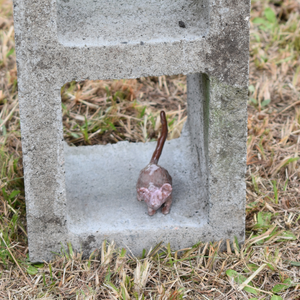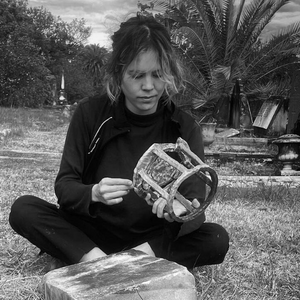a maus called liam (2022)
Rookwood clay, glaze, stains and oxides

This work uses clay collected from Rookwood Necropolis to create a playful assemblage of fictive artefacts. Some works are a direct response to themes surrounding death, while others embody a creative research approach. Places hold stories, just as we embed our personal and collective stories into them. The clay that forms the artefacts is, quite literally, the ground on which the viewer stands. On their surface some parts display the raw clay, while others are decorated with coloured glazes. This creates a playful tension between elemental history and how it is interpreted and reshaped by the individual.
About the Artist

Benita Laylim is a multidisciplinary artist who lives on Gadigal Country in Sydney. She recently completed an honours year of Visual Arts at the University of Sydney. At present, her practice is focused on using found clays and site-based research to explore eco-centric ways of thinking. She makes functional ware at her pottery studio in Marrickville, called chūn.
Transcription
Hello, my name is Benita and my work for Hidden is titled ' a maus called liam'.
This work is an assemblage of small sculptures made from iron rich clay that I have collected from the Rookwood grounds. The clay forms are decorated with colourful glazes and are placed in such a way as a child might abandon their toys, to present as a scattering of playful objects.
For this project, I began my process by researching the various histories of Rookwood. What you soon discover when looking into Rookwood's past is that the narratives surrounding the site are as diverse as the myriad of people, plants and animals that reside here, both dead and alive, so I decided to take a meandering approach to research, allowing such aspects that piqued my interest to inform the work.
Among these are stories of individuals who were buried here, like the flamboyant Sydney character Bee Miles or the founding father of the famous department store, David Jones. I was also inspired by peculiar articles or historic notes, such as a herald piece about the elusive goats who took up residence here in twenty-fourteen or the contentious origin of the name, was it called Rookwood because of the local crow population?
Taking tidbits from my research into the site, I then turned to work with the clay, using it to form a dialogue between the research, my own imaginings and the physical material of the place. My overall intention was to bring a comedic and lighthearted approach to the exhibition. I wanted the work to contain hints of Rookwood's history, but with a sparkle of fun.
Given the difficulties we've all faced over the last couple of years, I wanted to make a work that could be humorous and a little silly. In the same way that I was able to discover narratives that enriched my perspective of Australia's largest Necropolis, I hope that viewers can find an interesting story to take away with them.